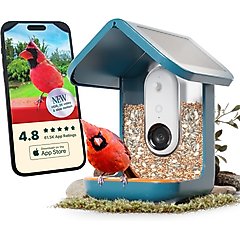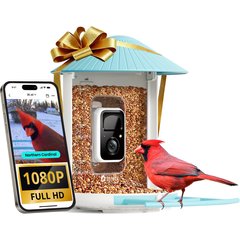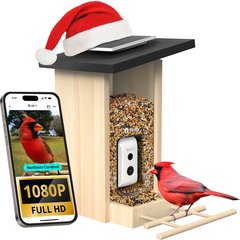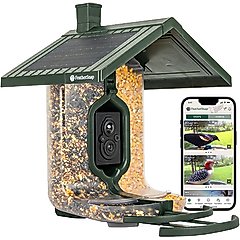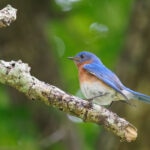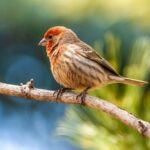Your Guide to Finding a Smart Bird Feeder That’s Right for Your Yard
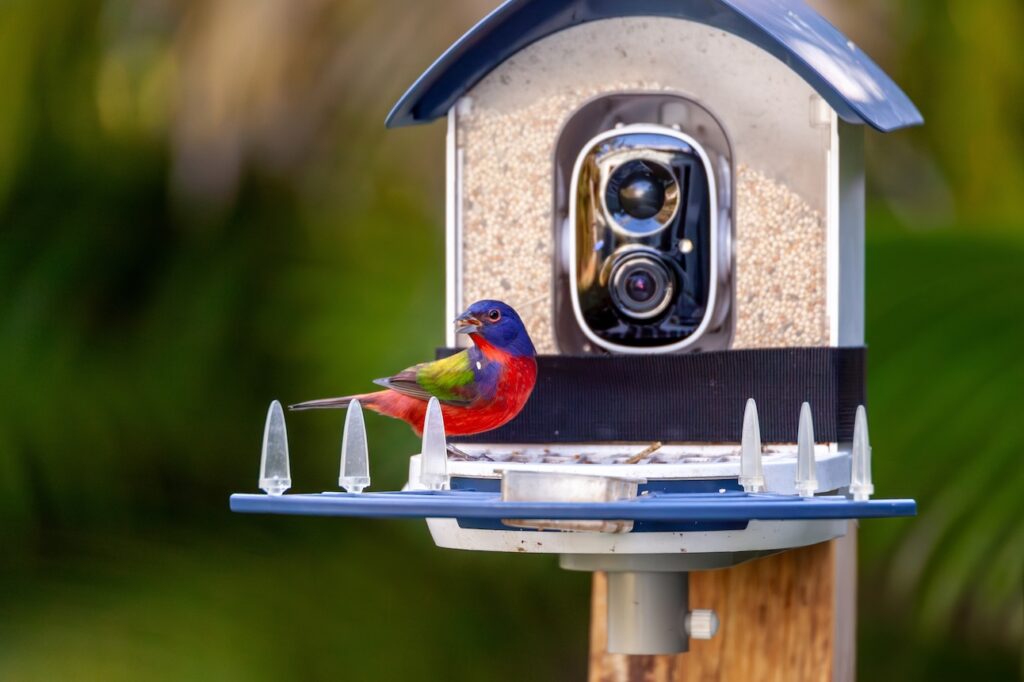
Photo by Adobe/SailingAway
Wish your bird feeder could snap photos of visitors and tell you who they are? Smart bird feeders are turning backyard birdwatching into a high-tech hobby. But fear not—these options are easy to set up and use. The best part? Birds love ‘em, too!
Key Takeaways
- Smart bird feeders use features like built-in cameras, Wi-Fi, and AI-powered apps to help identify birds visiting your yard.
- Choosing the right smart bird feeder depends on your priorities, such as video quality, solar charging, and whether the feeder can be mounted or hung.
- Set up a smart feeder where birds feel safe, where solar glares are minimal, and within Wi-Fi reach.
- Selecting the right bird seed will help attract your desired birds to your smart feeder.
What Is a Smart Bird Feeder?
Smart feeders differ from other types of bird feeders because they have several built-in features to help you watch and identify birds who visit.
If you’ve ever wondered what kind of bird was eating at the feeder (and what birdseed-buying human hasn’t?!), a smart bird feeder can help you determine species, sex, and even take close-up photos of your flighted friends.
Most smart bird feeders include a built-in camera, motion detection, and app connectivity. Some even use AI to identify bird species in real time—no bird book required.
The Best Smart Bird Feeders
Whether you’re a first-timer or a seasoned birder, there’s a smart feeder to fit your needs and style. The best smart bird feeder depends on what you’re looking for: photo quality, AI-powered bird identification, solar charging, or something more budget-friendly.
Think through which features are most important to you before adding one to your cart. Consider ongoing costs, like app subscriptions you’ll need to budget for, feeder size and installation, and the type of birds you’re hoping to attract. Reading product reviews can help you determine ease of use/setup, any Wi-Fi requirements, and charging capabilities.
The picks highlighted below include top-rated models from Bird Buddy, Birdfy, and FeatherSnap. Each has distinct features so you can choose the right feeder based on your birding goals.
Bird Buddy PRO Solar Smart Bird Feeder
Looking for a smart bird feeder that blends aesthetic design with cutting-edge features? The Bird Buddy PRO Solar Smart Bird Feeder is a top contender.
Recommended Product
It sends real-time bird photos and species identification to your phone—basically like having a digital field guide in your pocket. Features include a built-in camera, Wi-Fi connectivity, and a solar roof to keep your feeder powered up.
Things to Consider
- Includes a bird recognition app that uses AI to identify over 1,000 bird species
- Notifies you whenever birds visit and provides detailed info about each visitor
- Captures crystal-clear shots with 2K video quality, 5MP photos
- Weather-resistant
- Can be hung from a hook or mounted to a feeder pole
- No subscription required—basic functionality is free, but a paid Bird Buddy subscription unlocks bonus features
- Solar panels keep it charged, but the USB-C port works for backup charging if needed
Birdfy Smart Bird Feeder
Want to see which feathered friends are stopping by your yard, even when you’re not home? The Birdfy Smart Bird Feeder captures clear videos of every visit and sends motion-triggered alerts straight to your phone. It’s a stylish, Wi-Fi-connected feeder that doubles as a home for high-quality bird videos.
Recommended Product
Things to Consider
- Requires Wi-Fi to receive alerts and view the camera
- The Birdfy app is free, but an optional paid subscription gives AI-enabled bird recognition
- Designed to be mounted on a pole, tree, or wall (can’t hang from a hook)
- A 1080p HD video camera has night vision so you can watch birds day or night
- Motion detection feature captures video when birds visit
- Works with a memory card if you want to record footage without the app
- Rechargeable battery included, with optional solar panel sold separately
Birdfy Wooden Smart Bird Feeder
Another Birdfy bird feeder, the Birdfy Wooden Smart Feeder blends modern tech with a rustic aesthetic. Made with weatherproof materials and designed to look like a classic wooden birdhouse, it brings the charm of traditional backyard birding into the 21st century. It lets you monitor and identify avian visitors in real time—all through your smartphone.
Recommended Product
Ideal for bird watchers who appreciate both form and function, the Birdfy Wooden Smart Bird Feeder is a thoughtful upgrade for any backyard or patio.
Things to Consider
-
Real-time bird recognition with HD video streaming
- Can identify up to 6,000 different bird species
-
Stylish wooden design fits into natural landscapes
-
Compatible with solar panel for eco-friendly charging (sold separately)
-
Requires Wi-Fi and a power source to function
-
Some features locked behind a subscription
FeatherSnap Scout Smart Bird Feeder
The FeatherSnap Scout is a solar-powered smart feeder for birders who want to snap wildlife photos without lifting a finger. The camera captures and identifies birds, then shares images to your phone via an app.
Recommended Product
The app and Live View are free; however, an additional Wi-Fi subscription unlocks bonus features, like access to camera content and an AI-powered bird identifier.
Things to Consider
- Two feeder compartments for different kinds of seed may draw more species
- Wide-angle lens captures still photos and video
- App subscription unlocks features like AI identification
- Uses a memory card to store footage if there’s no Wi-Fi
- Dual power options include a solar panel and USB charging
- Designed to be mounted on a pole, tree, or wall (can’t hang from a hook)
Where Is the Best Place to Put a Smart Bird Feeder?
Proper placement makes a big difference in both the quality of your bird photos and how many visitors you attract. Here are a few tips to keep your smart bird feeder frequented by feathered friends:
- Keep it out of squirrel reach: Mount the feeder at least 6 feet off the ground and away from trees or fences squirrels can jump from. Adding a squirrel shield (also known as a baffle) to the pole is another way to keep them from eating all the seed before birds have a chance.
- Stick close to shrubs—but not too close: Songbirds will feel safer when feeders are near trees or shrubs they can dart into for cover, but not so close that predators can hide nearby. Aim for placement about 10 feet away from vegetation.
- Avoid glare on the camera: Position the feeder so it’s shaded during the brightest parts of the day. This prevents glare on the lens, keeping your photos crisp and clear. Facing the feeder north or east usually works best.
- Stay within Wi-Fi range: Because most smart feeders connect to an app, make sure it’s close enough to your router for a strong signal. If the Wi-Fi in your backyard is spotty, consider adding an extender to avoid dropped connections.
- Consider nearby windows: The National Audubon Society says feeders and bird baths should be one of two things to avoid deadly collisions: either a minimum of 30 feet away from windows or very close to them, so birds don’t have enough room to pick up speed. It’s a good idea to bird-proof reflective windows by adding decals to reduce their chance of birds colliding with the glass.
- Pet-proof your yard: It’s always a good idea to keep your cats indoors. It’s a lot safer for them inside, and much safer for the birds. According to the American Bird Conservancy, cats kill about 2.4 billion birds every year.
What’s the Best Seed for Smart Bird Feeders?
The best seed for any bird feeder depends on the regional birds you want to attract. Here are a couple options to try in your new feeder.
- Black-oil sunflower seeds: Great for cardinals, chickadees, finches, and nuthatches.
- Safflower seeds: Attract cardinals, chickadees, nuthatches, and grosbeaks (but squirrels don’t like it!)
If you’re hoping to attract different kinds of birds, try a seed mix or a non-seed food option. Just watch out for seed blends that contain a lot of corn or millet—they can sometimes create a mess beneath the feeder that will attract ground squirrels and other wildlife who sniff out a snack.
